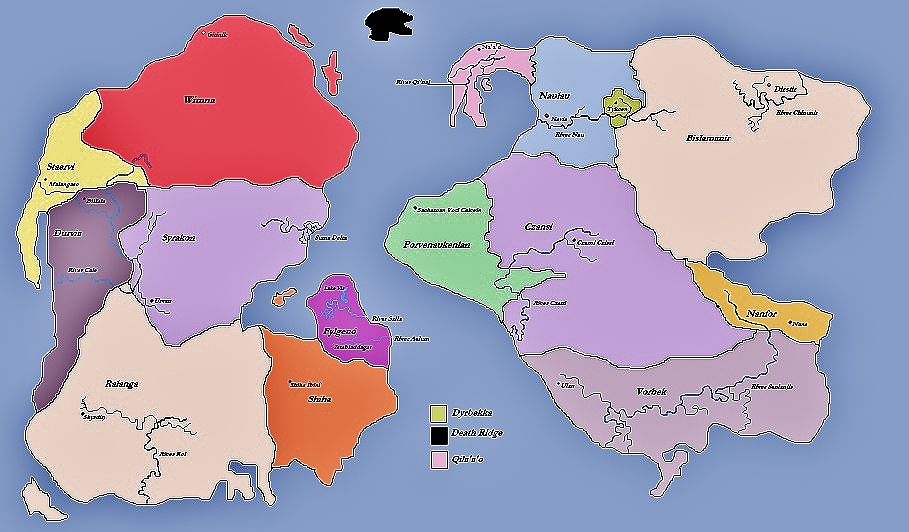Irfik
| Population: | 446,593,300 |
| Mean Distance from Epsilon Indi: | 31,480,000 m |
| Distance from our solar system: | 12 Light Years |
| Orbital Period: | 1 y, 364 d, 8 h |
| Eccentricity: | .04447 |
| Rotational period/day length: | 49.3 h |
| Circumference: | 28,445.018 km² |
| Surface area: | 296,415,100 km² |
| Axial tilt: | 14° |
| Mass: | .586 earth masses |
| Gravity: | 0.99987 g |
Irfik is an extra-solar planet which orbits the star Epsilon Indi [1] in the constellation of Indus [2] about 12 lightyears away from earth. It was discovered in 2056 shortly after Sheerflight travel was invented.
It consists of two large continents, 14 countries and one small, uninhabited volcanic island. It is home to about two billion people, who speak one of Sixteen indigenous languages.
Irfik also is home to 4 indigenous religions and two that have been imported, shall we say, from it's earthly visitors, Christianity and Islam. The indigenous religions are Solarriam, Mastalis, Vekun and the fourth Divismalah, a small minority religion.
Of the fourteen countries, Bislamanir is by far the largest and most industrialised, the capital of which is Dirsthir (Bis: Дусту). The official language is Bisla'ikh
The smallest country is a neighbour of Bislamanir's, Dyrbekka, who's capital is Tyćen (Dyr: Tykcen)
The uninhabited island goes by many names in the languages of Irfik, most agree on a certain morbidity to the name, the English speaking inhabitants call it 'Death Ridge' as it is a morbic, black, tarry, cliffy land. Of the twelve voyages in Irfek's history to Death Ridge, only 2 have ever come back. Little is known about the island, but many community legends have been created about it. More information some of the stories and mythologies surrounding the island can be found here
The countries of Irfik
| Country | Official Language | Capital City | Rounded Population |
| Bislamanir | Bisla'ikh | Dirsthir | 134,260,500 |
| Ralanga | Rolo | Shyrdiŋ | 109,160,000 |
| Staervi | Stish | Malangaso | 54,200,000 |
| Czansi | Czanak | Czansi Cziszi | 31,500,000 |
| Vorbek | Vorb | Ulan | 31,500,600 |
| Wimna | Wimnish | Gitinik | 28,000,100 |
| Syrakon | Sysh | Urvan | 28,250,500 |
| Durvia | Durvish | Bilřala | 15,400,500 |
| Naulau | Nauli | Navia | 10,240,500 |
| Porvenaukenlan | Porven Chili | Sachaman Voti Calvein | 10,100,100 |
| Shiha | Austar Îr | Shiha Îbinî | 3,400,500 |
| Fylgenó | Fyló | Istabladdagat | 5,400,000 |
| Qila'a'o | Qi | Na'a'o | 2,240,000 |
| Nanfor | Nanforish | Nana | 1,990,000 |
| Dyrbekka | Dabba | Tykcen | 950,000 |
The two other minority languages are a strong dialect of Bisla'ikh called Bisa, and there are a few sparse colonies of settlers and natives who speak English as a first language.
What year is it?
The Irfik calendar is used according to our rules, a year is one solar orbit, a day is one axis orbit, however, since the year and day on Irfik are just about twice that of Earth, you must half the year. So to us, Irfik was discovered in 2056, whereas to the inhabitants of Irfik, it would have been 1028.
Continents
Irfik has two Continents. This Bismic Continent and the Ranga Continent. Below is an image of the Irfik World Map, it shows the countries, their capitals and a few major rivers.
The black country at the top is Death Ridge, the unhabitable volcanic island.
=Rivers, Lakes and Seas
The continents are surrounded by one ocean which is know to the Irfikans as many names, dependig on which language you are speaking and which part of the world you are in. For example, Qilans call the sea the Ra'vi'i sa'afa'a or Cold Expanse (Qila'a'o is similar to Earth's Norway).
Fylgenans call the sea Yna Mellman or The Turquoise, due to their warm climes and barrier reefs.
